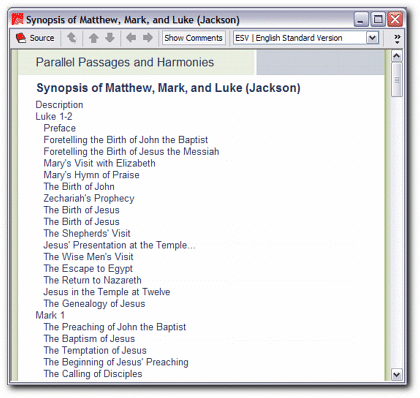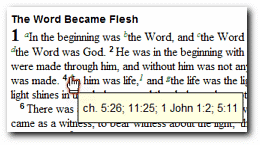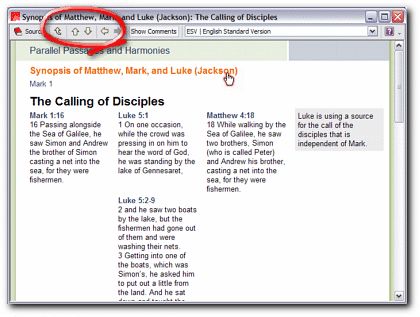If you’ve spent time around Logos Bible Software, you probably already know that Bibles such as the ESV, NKJV, and NASB* include cross-reference linksright there in the text. They’re indicated by the “little letters and numbers” sprinkled throughout most passages.
Just hover the mouse over an indicator and the cross-references pop up in what we call a “tool tip” window. Click the indicator (rather than hovering) and the tool tip will remain in place when you move your mouse away, allowing you to interact with the links inside the tool tip itself. This is a great way to see the cross-references—verses related to these verses—when reading through a passage.
But did you know that Logos also includes a more powerfultool specifically built for working with parallel passages, Gospel synopses/harmonies, and tables of quotations and allusions?
So you could spend thirty bucks to buy a printed “harmonized Gospel” which would give you a harmony in oneversion (NIV, for example)…or use the tool within Logos and viewthe harmonyin any Bible version you own, in any language!
Parallel Passages & Harmonies
The Parallel Passages & Harmonies tool is included in allthe Logos 3base packages—withincreasingly larger data sets available as you move up the product line. If you have a base package you should have at least four parallel passage data sets and maybe more!
To access the tool using Logos 3, click Tools | Bible Comparison | Parallel Passages and Harmonies. Click the Source button to choose a source—”Synopsis of Matthew, Mark, and Luke (Jackson),” for example. Then select a Bible version in the Bible version chooser box to the right.

You will see a table of contents that looks like the image above; click a title to open the report to that section. Here’s what it looks like when I clicked “The Calling of Disciples.”
Mark, Luke and Matthew contain an account of this event so they all show up here in an easy-to-read columnar alignment…in the Bible version I chose.
Notice the commentin the right-most column, which is supplied by Jeffrey Jackson, the editor of this data. To learn more about the source of each data set, click the first item in the table of contents, whichis a description. For this data set, the description explains the approach Jacksonused to create this synopsis and the meaning of special formatting used, such as blueor bolded text.
To get back to the table of contents at any time, just click the title of the data set (in this case “Synopsis of Matthew, Mark, etc.”).
Navigate to the next or previous section of the synopsis by clicking the down or up arrow (circled in red above). Clicking the hooked up-arrow moves you up one level—that is, it will load the entire chapter into the display.
The left and right arrows work just like the back and forward buttons in your web browser—jumping you back to the previous view or ahead (when applicable).
More is Better
The cool thing about having multiple, overlappingdata sets is that each editor follows a slightly different approach when assembling something like a Gospel harmony. All told, Logos packages include no less than six “parallel passages” data sets for the Gospels:
- Synopsis of the Four Gospels (Aland)
- A Harmony of the Gospels (Robertson)
- A Harmony of the Synoptic Gospels (Burton, Goodspeed)
- Synopsis of Matthew, Mark, and Luke
- Eusebian Canons (Eusebius)
- Records of the Life of Jesus (Sharman)
A quick glance at the Burton & Goodspeed harmony description shows that any project like this entails certain editorial choices that others may make differently:
“Our study of the Synoptic Problem, extending now through many years, has led us to certain very definite conclusions respecting the relation of the Synoptic Gospels to one another, and their literary sources. The purpose of this book, however, is not to demonstrate this theory; nor is its construction determined by that theory. It aims rather, as largely as possible in independence of all theories, to set the text of the several gospels in such parallelism as will make the facts themselves tell their own story with the utmost possible fullness and clearness.”
Because each data set is compiled by a different editor, each offers a unique perspective on the text. We offer as many as we can license, in hopes that your Bible study will be enriched!
* For the Logos editions of Bibles, we use the cross-reference data supplied by the publisher, which was generated by the publisher’s translation/editorial team. For some versions (e.g., NIV, NRSV) this data was not supplied by the publisher and so is not present in the electronic edition.






